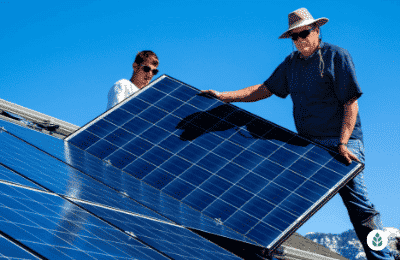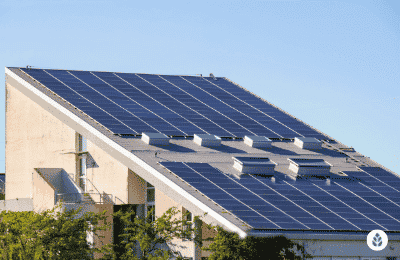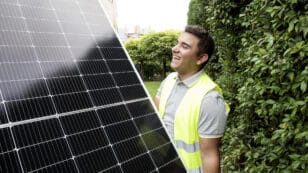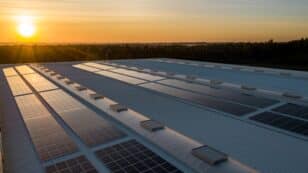
Is Solar Worth It in Louisiana? (2024 Homeowner's Guide)
- Here’s a quick overview of solar viability in Louisiana:
- Louisiana ranks 39th in the country for solar installations.*
- The average electricity rate is 11.23 cents per kilowatt-hour.**
- The average solar payback period is 16 years.***
- Homeowners are eligible for the Home Energy Loan Program (HELP) and the federal solar investment tax credit (ITC).
- The average homeowner saves $17,256 over the lifetime of their solar system.***
*According to the Solar Energy Industries Association.1
**Data from the Energy Information Administration.2
***Calculated assuming the system is purchased in cash.
Each product and or company featured here has been independently selected by the writer. You can learn more about our review methodology here. If you make a purchase using the links included, we may earn commission.
Solar adoption has been relatively slow in Louisiana, putting the state in 39th place in terms of the number of residential solar conversions in the country. With electricity rates that are well below the national average — 11.23 cents per kWh as opposed to the national average of 16.79 cents — many Louisianians wonder if installing solar panels is worth it in their area. The short answer is, usually, but there are several things you need to consider to determine if it’s worth it for your home. Below, you’ll find information on how to figure out your property’s solar viability and the total amount you could save over time by converting. We’ll also include some information on the benefits you can enjoy when converting to solar in LA, as well as some things you should know about the conversion process before you dive in.
To speak with an EcoWatch-vetted professional who can help you determine whether solar is worth it for your Louisiana home, follow the links below.

Solar Alternatives

Regional Service
Average cost
Pros
- Great warranty coverage
- Outstanding customer service
- Multitude of products and services
Cons
- No leases or PPAs

South Coast Solar

Regional Service
Average cost
Pros
- Outstanding customer service
- Offers products from leading manufacturers
- Great warranty coverage
Cons
- Expensive
- No leases or PPAs
Watch Below: Is Going Solar Worth It In Louisiana?
How to Figure Out if Solar Panels are Worth It in Louisiana
Going solar will save most Louisiana homeowners money in the long run, but figuring out if your home is a good candidate for solar is crucial before you convert to this renewable energy source. Below are some criteria you can use to figure out how valuable solar will be for your home.
What’s Your Home Electricity Consumption?
The amount of energy you consume on a monthly basis is a good first gauge to see if solar will be worth it for your home. A general rule of thumb is that solar should be a good investment for you if your energy needs exceed 500 kilowatt-hours per month. The more electricity you use, the more valuable solar will be over time. The actual benchmark in Louisiana is a bit higher — likely around 600 kWh — because of the below-average electricity rates.
Most Louisiana residents use around 1,201 kilowatt-hours per month, which is well above the national average of 881 kWh and far exceeds the 500 kWh benchmark for solar viability. As such, from a purely energy-consumption point of view, most Louisianians will find that solar is a worthwhile investment. You can check your past electric bills for your energy consumption history.
How Much Is It To Go Solar in Louisiana?
The price of solar panels in Louisiana varies quite a lot, depending on numerous factors, including the size of the system you need. Luckily, the price per watt in LA is around $3.39, which is only a bit higher than the national average of $3.33. The typical system size requirement in the area to offset electric bills is 12.5 kilowatts, which is above the US average, bringing the total to around $29,663 after the federal tax credit is considered.
Solar is more valuable where energy prices and consumption are high. Although Louisiana’s power rates are below average and consumption is above average, the high price of solar panel systems in the area means that solar is generally less valuable than it is in most other states. However, the majority of homeowners still save money by going solar — the average savings after panels pay for themselves in Louisiana sit around $17,256.
What’s the Payback Period for Solar in Louisiana?

The average solar energy system in Louisiana takes between 13 and 19 years to pay itself off, with a typical timeline of around 16 years. This is above the national average of 11 years and the average range of 8 to 14 years. As such, solar isn’t as valuable in Louisiana as it is in most other states. The typical savings after your panels pay for themselves in LA will be $17,256, which is less than in the rest of the country, which averages around $31,513. If your payback period is longer than 16 years, your return on investment will be even lower.
What Are Average Buy-Back Rates in Louisiana?
Most states have mandated some net metering policies or an electricity buy-back program for solar customers. Through interconnection via your inverters, these programs let you sell your excess energy production to your utility company for credits to your power bills.
Unfortunately, net metering is not mandated in Louisiana. Some electric companies will offer it, but they typically buy back energy at a reduced rate. If you don’t have net metering available from your electricity provider or if yours offers a buy-back rate that’s below the retail rate, you will likely have to add a solar battery package to your home solar project to eliminate your electric bills. These storage solutions will between $10,000 and $20,000 to your installation expenses in most cases, but they often pay for themselves over time because they afford you effective net metering at the retail rate.
How Much Sun Does Your Roof Receive?
Solar panels only generate electricity when they receive sunlight, which means photovoltaic equipment is more valuable in areas where abundant sunlight is available. Louisiana receives around 216 sunny days per year, which is above the average of 205 days throughout the rest of the country. From a sunshine availability standpoint, solar is worth the investment in Louisiana.
However, there are some individual factors you need to consider as well. Namely, the direction your roof faces and the shading on your roof. South-facing and west-facing roofs are the best options in the US as they receive the most sun. If your roof faces north or east, solar might not be an option at all for you. Additionally, shading on your home from trees, buildings or other structures will reduce the amount of sun available, the amount of energy produced overall and, therefore, the value of your solar equipment.
What’s the Outlook on Solar in Louisiana?
Unfortunately, solar adoption has been very slow in Louisiana, in large part because the state government offers tax incentives and other perks to the oil and gas industries. Residential solar installations jumped in popularity in 2014 and 2015 but dipped the following year and dropped even further in 2018 when the state tax incentive came to an end.
Generally speaking, solar energy isn’t promoted in the state, given the dependence on fossil fuels. The state is one of the few in the country that doesn’t have a Renewable Portfolio Standard (RPS) goal. Hopefully, as the country as a whole becomes more environmentally conscious, the policies in Louisiana will change and make solar a more favorable source of power.
Benefits of Solar Energy in Louisiana
Despite the slow adoption of solar energy in Louisiana, there are numerous upsides you can enjoy when you convert to clean energy. Below, we’ll discuss some of the most appealing benefits of going solar in the Pelican State.
Electricity Bill Savings
Most prospective solar customers know that the most substantial financial benefit of solar panels will be the energy savings they provide. Solar panels produce energy that offsets your energy bills, which means you’ll save money every month on electricity. In Louisiana, where the average homeowner pays around $134.87 for electricity, the potential annual savings totals $1,618. After your solar power system pays for itself, the additional savings you’ll enjoy average about $17,256. Your savings could end up being higher if electricity rates continue to climb, as they are expected to do. Installing solar panels effectively lets you lock in a lower electricity rate for the 25+ years of system life.
Lower Taxes & Access to Other Incentives
Although Louisiana isn’t the most solar-friendly state, there are some solar incentives available from both the state and federal governments. One of the most substantial incentives is the federal solar tax credit (ITC), which credits your federal income tax liability with 26% of your total solar panel installation expense. In Louisiana, the average ITC amount is a massive $12,713. There are some additional state incentives in Louisiana you can take advantage of when installing panels on your home:
- Solar Energy System Exemption: This is a property tax exemption that prevents your property taxes from increasing. Without this exemption, the increase in home value you’d enjoy from going solar would be less beneficial due to a hike in property taxes as a result.
- Home Energy Loan Program (HELP): Louisiana’s Home Energy Loan Program makes solar financing more accessible and more affordable to residents. Loans come with lower interest rates and lower down payment requirements than normal.
- New Orleans Solar For All: Solar for All NOLA is a program designed to make solar more accessible to low-income homes in the New Orleans area. Those who qualify can enjoy no interest and a nominal down payment. This program is effectively a solar leasing program, which can be useful for qualifying individuals.
Home Resale Value Increase
One of the most significant and often most surprising benefits of going solar is that your property value will increase when you install solar panels. According to nationwide research done by Zillow, the average home will jump up in value by around 4.1% with the installation of a solar energy system.3 Given the average home value in Louisiana of $194,453, that’s a typical value bump of approximately $7,972.4
Your added value could be higher if you live in a more expensive area, like New Orleans, Baton Rouge or Lafayette. It’s important to note that your property value will only increase if you pay for your panels using cash or a solar loan. You’ll be passing up this benefit if you choose a solar lease or power purchase agreement (PPA).
Clean, Renewable Energy
For Louisianians who are more environmentally aware, going solar will provide some non-financial benefits that are quite appealing. All while your panels are saving you money on electric bills, you’ll also be reducing your carbon footprint, your reliance on fossil fuels and your contribution to air and water pollution. Solar panels offer the unique opportunity to benefit the environment and provide you with financial incentives simultaneously. You’ll also become more energy independent, which will be a welcome benefit if electricity rates continue to go up.
What to Look Out For When Considering Solar in Louisiana
Even if you determine that your home is a good candidate for solar panels, there are still some things you should consider before you pull the trigger and contact a solar panel installation company. We’ll discuss some important things to understand and think about before you convert to clean energy.
Upfront Fees

Payback Period
As mentioned above, the payback period for your solar system is a crucial factor to consider. Not only does it help determine your long-term savings, but it also provides some insight into how valuable solar is for your property. The typical LA homeowner has an estimated payback period of 13 to 19 years. If yours is longer than 19 years, your ROI will be lower than average. You can use a solar calculator to estimate your payback period or contact an experienced solar installer to calculate the time frame for you.
Net Metering Policies in Louisiana
Net metering is a great option for solar customers where it’s available because it increases your return on investment, reduces your payoff time and makes your panels more valuable overall. The Louisiana Public Service Commission doesn’t mandate net metering, so you’ll have to check with your power provider to see if a program is available to you.
If you don’t have access to net metering or get credited below the retail rate for energy, you might want to consider adding a solar battery to your setup. This will add between $10,000 and $20,000 to your installation expenses in most cases but often pays for itself over time.
Pending Policies & Changes to Incentives
The solar industry is still expanding and improving, especially in areas like Louisiana, where solar adoption has been limited thus far. Incentives that are currently available could expire soon, new ones could be added and existing rebates or incentives can change. While it’s not usually a good idea to wait for better incentives to come along, you should check for changes or new policies before you commit to installing solar panels.
Weather & Climate in Louisiana
Solar panels are generally best in areas closer to the equator, where sunlight is most abundant and intense. Even in these areas, cloudy days can significantly reduce solar panels’ efficiency. The State of Louisiana is a great place for solar conversion because the state as a whole receives about 216 days of sunlight per year. This is more than the national average and enough to make going solar a good investment for most people. Some homeowners in the area worry about the effects of tropical cyclones and hurricanes on their panels and their roofs once panels are attached. Rain isn’t typically an issue, as it will normally just keep your panels clean and improve efficiency for the following sunny days. High winds can be a problem for solar panels in the area, but hiring a solar installer that provides a robust warranty is usually enough to provide some peace of mind.
Companies Pushing Solar Leases or PPAs
Finally, you need to be aware that not all solar panel installation companies are equal, and some don’t have your best interests at heart. Specifically, you should be on the lookout for companies that advertise “free panels” or promote solar leases or power purchase agreements (PPAs). These options are far from ideal, as they don’t let you take advantage of the federal tax credit, they don’t bump up your property value and they provide far fewer energy savings over time. While pushing less beneficial leases and PPAs isn’t a good image for a solar installer, others in the area are a bit more nefarious. There are some lawsuits pending with some solar panel installation companies in Louisiana who have committed fraud.5 Other reports of overstated savings and benefits from Louisiana solar companies are, unfortunately, also a common occurrence.6 It’s in your best interest only to work only with reputable, vetted solar installers with a history of success in your area.
With all of that being said, leases and PPAs are more popular in Louisiana than they are in many other states. This is partially because of the above-average cost to go solar, especially for homeowners who don’t have access to net metering — which includes most in Louisiana — and need to invest an additional $10,000 to $20,000 or more on batteries to see a decent ROI over time. The bottom line is that leases and PPAs aren’t always bad, but they are less beneficial than a cash purchases or solar loan.
Wrap Up: Is Solar Worth it in Louisiana?
Generally speaking, Louisiana is a great place for solar conversion, and most homeowners will find that installing a solar panel system is a worthwhile investment. With that being said, solar is not right for everyone, and assessing your home beforehand for solar viability is a good way to ensure you save money rather than lose your investment. Some factors to consider include the orientation of your roof, the size of the system you need, shading on your property, your solar panel payback period and more. We strongly recommend getting in touch with a reliable solar panel installation company in your area to help you figure out if solar is a good fit for your home.
See also: Find out how much solar power your roof can produce with our solar calculator
Read More About Going Solar
- What Are the Best Solar Companies in Louisiana?
- What Solar Incentives Are Available in Louisiana?
- Find Cost Savings on Solar in Louisiana
The cost information presented in this article is derived from a comprehensive analysis, incorporating data from multiple industry sources. The average cost per watt per state was calculated based on figures from Consumer Affairs, Energy Sage, and Berkeley Lab’s Electricity Markets & Policy Department. Additionally, monthly energy consumption and the average monthly cost of electricity were sourced from the U.S. Energy Information Administration, ensuring a well-rounded and accurate representation of the information presented.
Frequently Asked Questions
The EcoWatch team is thrilled to get questions regularly from Louisiana homeowners about the prospect of going solar, as it just proves that solar is becoming more widely accepted in the area. Below are the questions we see most often, along with our responses. If you have specific questions that aren’t answered here, reach out to our team of solar experts at solar@ecowatch.com.
Most home solar systems pay themselves off in Louisiana in about 16 years, which is above the national average of 12 years. A solar panel payback period between 13 and 19 years is considered normal in the area. If you use a solar calculator or contact a solar installer to estimate your payback period and find that it’s longer than 16 years, it will take you longer than normal to recuperate your investment, and your total return on investment will be lower than the average of $17,256 in the area.
In most cases, solar panels will save you money. While you’ll spend an average of $29,663 on your solar panel system in Louisiana — after the federal tax credit — the typical homeowner in LA will enjoy energy savings that pay off the installation expenses within 16 years and then get additional savings totaling around $17,256.
Yes! Installing solar panels will increase your property value by an average of 4.1%, according to estimates from Zillow. In Louisiana, that means the typical bump in value enjoyed from the solar conversion is around $8,009. Solar leases and power purchase agreements (PPAs) are not expected to add any value to your home, so this average applies to cash purchases and solar loans only.
Yes, permits are required for solar panel installation in Louisiana. Permits help your local government ensure that your solar installer connects the panels to the grid safely and that your home can support the weight of the panels safely. Your solar panel installation company will usually handle the permitting process for you.
You can install solar panels yourself in Louisiana, but it’s not the best idea. Rooftop solar installation is dangerous, and mistakes can put your home at severe risk of damage, especially in an area like Louisiana, where extreme weather is relatively common. We strongly recommend deferring all installation work to a reputable solar installer in your area.
Top Solar Installers in Louisiana Cities
Comparing authorized solar partners
-
- Great warranty coverage
- Outstanding customer service
- Multitude of products and services
- No leases or PPAs
A+Solar Veteran
Having trouble deciding? Click below and use our process to receive multiple quotes instead:

 233k
233k  41k
41k  Subscribe
Subscribe 



